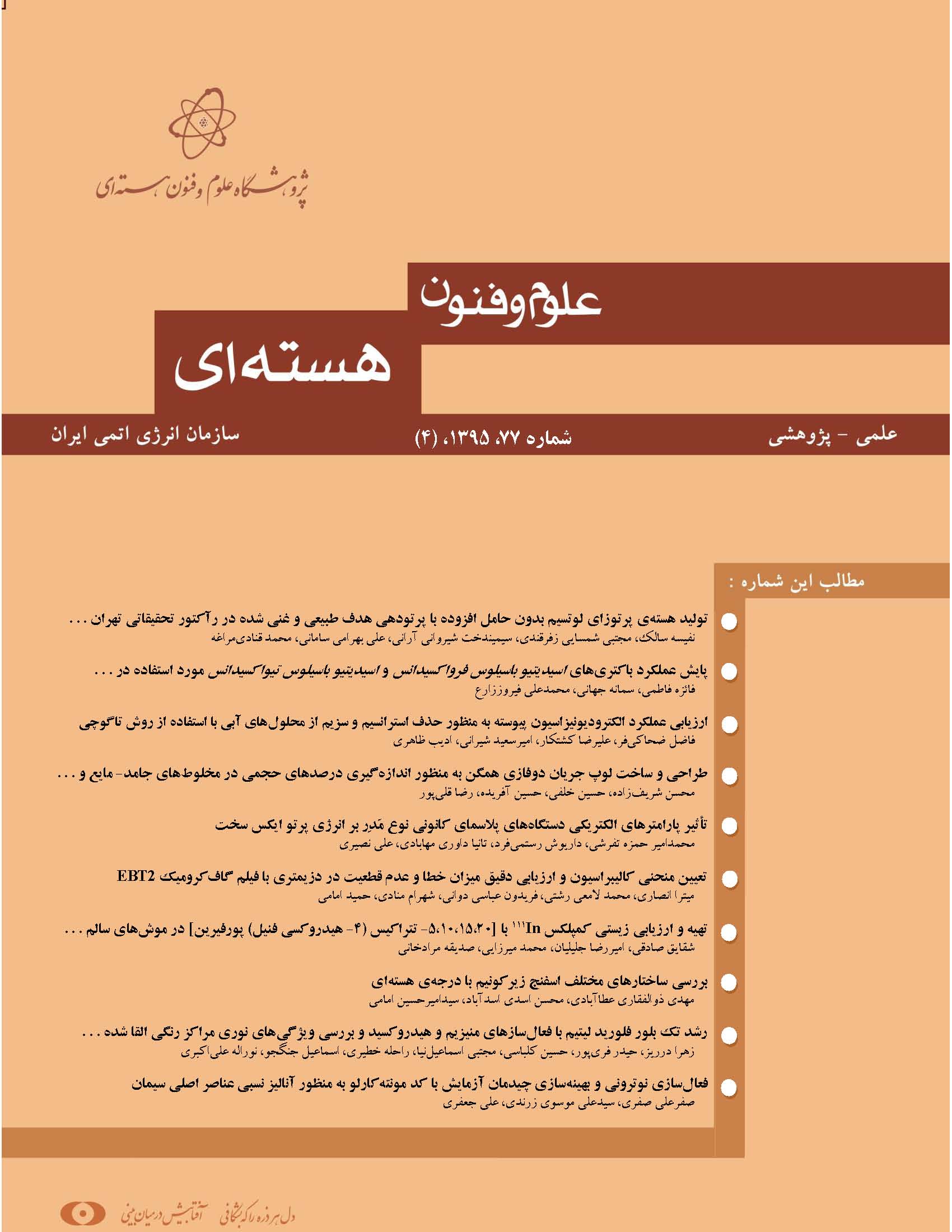نوع مقاله : مقاله پژوهشی
نویسندگان
1 پژوهشکدهی کاربرد پرتوها، پژوهشگاه علوم و فنون هستهای، سازمان انرژی اتمی ایران،
2 گروه مهندسی هستهای، دانشگاه علوم و فنآوریهای نوین، دانشگاه اصفهان
3 گروه مهندسی هستهای، دانشکدهی علوم و فنآوریهای نوین، دانشگاه اصفهان
4 گروه مهندسی هستهای، دانشکده علوم و فنآوریهای نوین، دانشگاه اصفهان
چکیده
شمارندههای کل بدن برای اندازهگیریهای مستقیم پرتوزایی بدن و ارزیابی پرتوگیری داخلی برای پرتوکاران و دیگر افراد جامعه استفاده میشوند. شمارندهی با هندسهی صندلی نسبت به دیگر هندسهها برای پایش سریع در حوادث پرتوی، مناسبتر است. در این پژوهش، سیستم پایش قابل حملی با هندسهی صندلی، طراحی شد و ارزیابی بازدهی شمارش برای کالیبراسیون سیستم انجام گرفت. این سامانه از یک آشکارساز سوسوزن یدور سدیم (قطر cm5×cm5) قرار گرفته داخل یک موازیساز، و یک صندلی که با لایههای سربی به ضخامت
2cm حفاظت شدهاند، تشکیل شده است. برای محاسبهی زاویهی صندلی و زاویهی موازیساز، از مدل فانتوم بومَب استفاده شده است. بازده شمارشها از راه شبیهسازی مونتهکارلو و آزمایشهای کالیبراسیون معمول و با استفاده از یک فانتوم نیمتنهی حاوی چشمهی نقطهای به دست آمد. کمینهی سطح پرتوزایی قابل اندازهگیری (MDA) برای چشمهی Cs137 در محدودهی زمانی min 10، برابر با Bq 47±448 بود. نتایج حاکی از آن است که کالیبراسیون شمارندهی کل بدن با کد MCNPX میتواند جایگزین کالیبراسیون واقعی شود. همچنین نشان داده شد که شبیهسازی مونتهکارلو، یک روش ارزانقیمت برای به دست آوردن بازدهی شمارندهی کل بدن از نوع صندلی برای مقاصد طراحی و کالیبراسیون است.
کلیدواژهها
عنوان مقاله [English]
Design and Calibration of a Chair-Type Whole Body Counter
نویسندگان [English]
- H Poorbaygi 1
- S Pourali 2
- M Mostajaboddavati 3
- S Bagheri 4
چکیده [English]
A whole body counter is used for in vivo measurement of body radioactivity to access the internal exposure of radiation workers, as well as, the internal exposure of the public. The chair-type WBC is more suitable than the other geometry for rapid monitoring in radiation accidents. In this study, a transportable in vivo monitoring system with the chair-type geometry has been designed, and evaluation of the counting efficiency has been performed to calibrate the system effectively. The counter incorporates Nal (Tl) detectors (5cm dia.×5cm), housed in a collimator, and the chair is shielded using 2cm thick lead layers. For calculating the seat angle of the chair and collimator angle, a Bottle Mannkin Absorber (BOMAB) phantom model has been used. The counting efficiencies have been obtained by using Monte Carlo simulation and from the conventional calibration experiment. For the calibration experiment, a torso phantom containing a point source is used. The minimum detectable activity (MDA) for 137Cs for 10min counting interval is 448±47 Bq. The results indicate that the calibration of the whole body counter by the MCNPX code can be substituted for the actual calibration. It is shown that, the Monte Carlo simulation is an inexpensive alternative method to obtain the counting efficiency of the chair type WBC for design and accurate calibration purposes.
کلیدواژهها [English]
- Whole-Body Counter
- Calibration
- Efficiency
- Monte Carlo Simulation
- BOMAB and Torso Phantom

